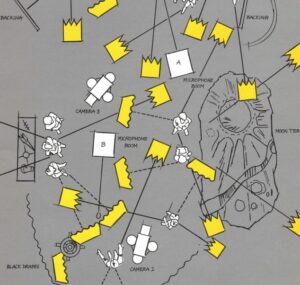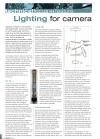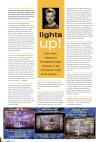
Lighting Plan for TV Studio (from Strand Lighting booklet)
Lighting for TV and Film production is constantly evolving, in the same way that lighting for theatre is changing.
However, they are very different crafts.
Film lighting, in the early days, was about massive light sources, to provide enough light for the film cameras. When colour film was first used, the light levels had to be even higher, and the colour temperatures had to accurately match other light sources in the scene. Studio soundstages were places of huge light sources and huge amounts of heat and lighting on location was energy-intensive, expensive and unwieldy.
As technology moved on, film stocks became far more sensitive, and light levels could be reduced. Similarly, digital cameras of today are able to operate with very low light levels, and more stylised and realistic lighting is now very achievable (see Wolf Hall example below).
In both TV and Film, the job of ‘Lighting Designer’ does not exist in the same way as in theatre / events.
Some TV productions have a ‘Lighting Director’ – see the ScreenSkills website for a wealth of information about the job.
The Director of Photography (or D.O.P.) is responsible for the technical processes that capture the image as the Director requires. This includes selecting the lens, and all aspects of where the camera is positioned and how it moves, as well as instructing the Gaffer and Board Operator where to put lighting and how it should be controlled.
Theatre lighting designers don’t worry about F-Stops and lumens, only how the lighting actually looks to the human eye. TV and Film cameras are much less forgiving, and don’t automatically adjust and recalibrate when the lighting changes (which the human eye does imperceptibly). So lighting for camera has a higher requirement for consistency and accuracy of both light levels and light source colours. Early computerised lighting controls were developed to meet the accuracy needs of TV lighting in the 1970s. Levels had to be maintained, and be repeatable (so the lighting on day two of the shoot could be set exactly as it was on day one), and the colour temperature of the light had to be exact, so ‘daylight’ through the on-set windows matched the daylight shot on location weeks or months earlier, and would be cut together so they seemed to be a single location.
Basics
In the same way as the McCandless Method is taught as a way to light theatre, there’s a standard method for lighting for video. It’s based on three light sources, one brighter than the others, which is known as the Key Light. Others are known as Fill Light.
Light is still used for atmosphere, as well as having a more straight-forward function to provide visibility, and enough light for the cameras to be able to register the image.
Equipment
Instruments: The archive section on this site contains examples of equipment by Quartzcolor / Strand Lighting, which is extensively used in the UK / European Film & TV industry. You can also read about the different Types of Lanterns in the entertainment industry.
Control: UK TV studios used Strand Galaxy lighting control systems extensively from the 1980s to 2000s. Nowadays, control systems by companies such as Avolites, GrandMA and ETC are used.
Manufacturers
Mole-Richardson
Strand / Quartzcolor
Further Information
Amazon Shop
Notable TV Shows
Top of the Pops (1964 – 2006)
1964 – 1991: BBC TV Centre
October 1991 – 2006: BBC Elstree (Studio A)
Wolf Hall (IMDB) (2015)
Shot with Arri Alexa camera which meant traditional TV studio lighting was not necessary. Candlelight was used as the main light source in many sequences. [ref: The Guardian]. The cinematographer Gavin Finney is interviewed on the British Cinematographer website.
Daytime TV / News Lighting
Sitcom Lighting
Bright, diminished contrasts, flattering
Cinematic Lighting
High contrasts, more defined angles/directions, more intense colours
What Happens When a Movie Has No Gaffer?
Cinematographer – Roger Deakins Masterclass
Associations
Society of Television Lighting and Design (UK)
Credits:
First online April 2018, updated February 2024
Author: Jon Primrose
Keywords: TV Lighting, Film Lighting, Television Lighting, Lighting for Television, Lighting for Film, Motion Picture Lighting, Lighting for Movies, Movie Lighting, Sitcom Lighting, TV Drama Lighting, Television Drama Lighting, 3 Point Lighting










